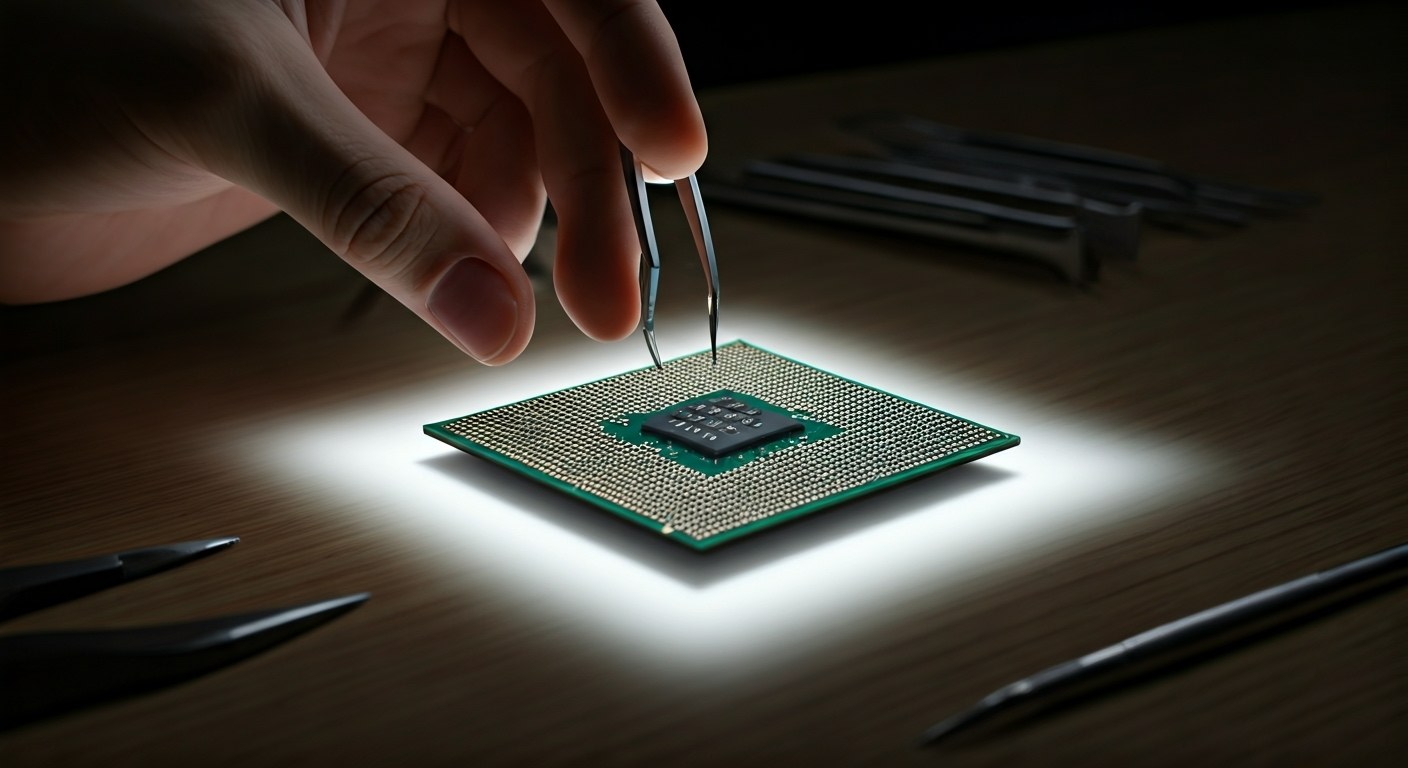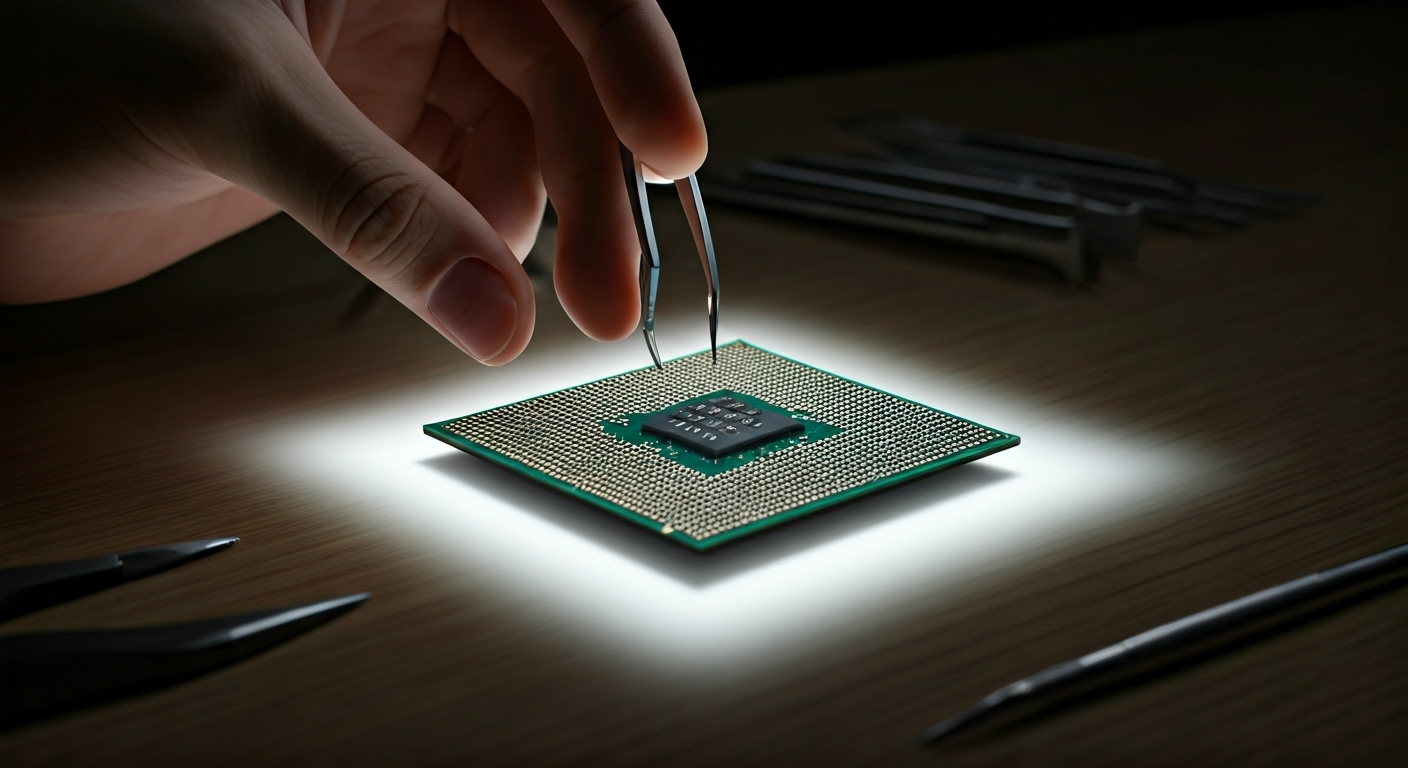Key Highlights
- Accurate inspection of CPU pins using a magnifying glass and bright lighting is crucial for spotting bent or damaged pins.
- Safe handling and removal of your CPU from the socket help prevent accidental pin damage.
- A pinout diagram and proper tools, such as precision tweezers, support a precise and thorough visual check.
- Bent or misaligned CPU pins can cause system instability, random crashes, or failure to boot.
- Minor pin bends may be repairable using careful techniques, while severe damage might require replacement.
- Always match the CPU alignment markers and avoid forcefully inserting your CPU into the motherboard socket.
Introduction
CPU pins are small and easy to break. You can find them under many processors, including various CPUs. These pins help the CPU connect to the motherboard socket the right way. If even one pin is bent or broken, the CPU may not work. Your PC can stop working or may not start at all. It is good to learn how to check for a bent or broken pin. This can help you keep your PC safe and save money on repairs. Are you ready to look at your CPU pins? Let’s go through each step together.
Preparing to Inspect Your CPU Pins
Before you start, make sure to turn off your PC and unplug it from any power source. This will keep you and your PC safe from shocks and static. Take off the side panel of your computer so you can get to the motherboard and find the CPU socket.
When you take out the CPU, hold it only by the edges. Don’t touch the pins because they are very easy to bend. If you do not know the way the pins are set up, look at a pinout diagram made for your cpu model. Using this diagram will help you not make mistakes or damage things when you check the cpu or the socket.
Essential Tools and Lighting for Clear Visual Inspection
Having the right tools and lighting is important for a clear look at your CPU pins. Before you begin, make sure to have these things ready:
- Magnifying glass or jeweler’s loupe: This helps you see the tiny bent pins on the CPU.
- Pinout diagram: Using this diagram lets you check how the cpu pins should be set and helps spot if any are missing or bent weirdly.
- Flashlight or strong desk lamp: This bright light helps shine over all the cpu pins, so you can see any that are bent or not lined up right.
- Mobile app or camera with macro mode: You can use these to take close-up pictures, making it easy to check small pins and compare your cpu to the pinout diagram.
When you use a magnifying glass with strong light, you will see more problems that you might not notice with just your eyes. Try shining the light at an angle over the cpu pins, and you will often see the bent pins more clearly. With the right tools—like a good app, a pinout diagram, and the best lighting—you have a much better chance to do a full check and not miss any small but important issues.
Safe Techniques for Removing and Handling Your CPU

How to test that all CPU pins are in good working order?
To test CPU pins, visually inspect them for any bending or damage. Use a magnifying glass for better visibility. Gently straighten any bent pins with a precision tool. Additionally, ensure proper alignment when inserting the CPU into its socket, as this can prevent future issues and guarantee optimal performance.
Begin by making sure you are grounded to stay safe from static electricity. This is important because static can damage the cpu and other parts. Use an anti-static wrist strap if you have one. If not, touch a metal part of your computer case before you start working on the cpu socket.
Unlock the cpu socket by slowly lifting the arm. Hold the cpu by its edges, not by the pins. Do not touch the pins directly because they are easy to bend.
If you try to get out the cpu and it feels stuck, do not try to force it out. Gently move it from side to side. Keep your pull even and light. When you hold the cpu, put it on a clean, static-free surface with the pins facing up. This helps keep the pins from getting more bent. If you see a bent pin, use tweezers or a mechanical pencil tip to move it back into place with care and precision.
Use caution and take your time. Patience is important to avoid making things worse. If you hurry or use too much force, a small problem with the cpu or socket can turn into a big, expensive one. With the cpu out, you are all set to take a good look and move on to the next step.
How to Perform a Detailed Visual Examination
Are you ready to take a close look at your CPU pins? Start by looking at the cpu pins with a magnifying glass. Make sure you are in a place with good light. Hold the cpu so all the rows of pins line up with your eyes. Then, gently turn the cpu to see it from different sides.
Bent pins on the CPU, including those on modern Intel CPUs, will stick out, twist, or even look flat instead of straight. Take your time to look over every row and column. If you see something that looks off, make a note of where it is so you can check it later. Now, let’s talk about the best ways to do this CPU pins inspection well.
Using Magnification and Proper Angles to Spot Bent or Damaged Pins
Good technique really helps when you look for bent or broken cpu pins. First, take a bright light and shine it across the cpu pins from the side. Then look straight along the rows at eye level. This way, the light will cast little shadows, and you can see pins that are bent or not lined up right.
A magnifying glass or a jeweler’s loupe is great for seeing all the details better. Move your eyes slowly across the cpu from edge to edge, and check each row both up and down, and side to side. Doing this “north-south” and “east-west” look helps to find small bends or problems that you may miss at first.
If you are still not sure about some cpu pins, you can take a close-up photo with your phone. Zoom in and look at your cpu with a pinout diagram. Artificial intelligence (AI) apps can also point out spots that might be a problem, making this look more simple. If you use precision, take your time, and keep the right angle, you will often catch what you can’t see right away with just the eye.
Common Types of Pin Damage and What They Look Like
Not all pin damage is the same—some issues can be fixed, while others require replacement. Here’s what to watch for as you inspect your CPU pins.
|
Pin Damage Type |
What It Looks Like |
Potential Fix |
Impact on System |
|---|---|---|---|
|
Slightly bent pin |
Pin tilts at a minor angle; still attached |
Usually repairable |
May cause instability |
|
Severely bent pin |
Pin nearly flattened or sharply angled |
Difficult to repair |
Boot errors likely |
|
Broken/missing pin |
Pin snapped off, missing from base |
Not repairable |
May not boot at all |
|
Twisted or misaligned |
Pin rotated or angled away from row |
Sometimes repairable |
Intermittent issues |
Bent pins can affect data or power signals between the CPU and the motherboard. If you find a pin is broken off, refer to a pinout diagram to see if it’s a “dummy” pin—if not, replacement is usually required. Remember, “Even minor misalignments can lead to major system trouble,” as hardware expert Carsten Frauenheim notes.
Conclusion
To sum up, it is important to check your cpu pins for any damage. This helps your cpu work better and can make it last much longer. You can use the step-by-step guide to find problems with your cpu pins. If you see anything wrong, you can fix it right away. Taking care of your cpu and doing regular checks stops many problems before they start. This will help your system run well. Do not forget how helpful this can be. If you stay on top of things and check your cpu pins often, you are protecting your computer. If you need help or want to talk to someone about it, you can get a free talk with our experts.
Frequently Asked Questions
What should I do if I find bent CPU pins during inspection?
If you see that your CPU pins are bent, you can use precision tweezers or a mechanical pencil to try to straighten them. Be very careful and gentle while you do this. The cpu pins can break if you bend them too much or too often. If you feel that the problem is big or you are not sure what to do, it is good to ask a professional for help before you go on. Always use care and caution when handling a cpu.
Can damaged CPU pins affect my warranty or RMA eligibility?
Yes, if your CPU pins are bent or broken, it will often void the warranty. Most manufacturers say that physical damage like this is from the user. You should always read the warranty terms before you try any repair. If the CPU gets to you already damaged, contact the seller or manufacturer right away. Do not try to fix the bent cpu pins by yourself.
Are there easy ways to test if the CPU pins are functioning without advanced tools?
You can put the CPU back in and see if your system starts up and works as it should. If you see crashes, errors, or if the system stops working, that may mean there are pin problems. While you can use diagnostic apps, just getting a steady boot and smooth running on your motherboard is often the best way to check at first.
Can bent pins damage a CPU?
Yes, trying to put in a cpu with bent pins can hurt the motherboard and the socket. Bent pins might stop the cpu from making the right electrical contact. If you try to force the cpu in, it could cause damage that cannot be fixed. Always check that all cpu pins are straight and lined up well before you install it.


0 comments